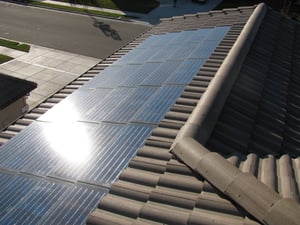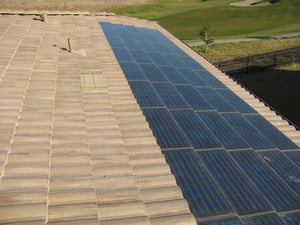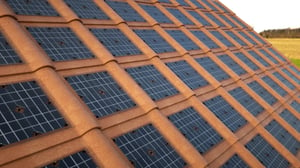The experts at Citadel Roofing & Solar have long been bullish about the potential of solar roofing products like shingles and tiles. But the reality is, the price for homeowners and business owners to install solar roofs just hasn’t come down enough to warrant installation for most people.
Still, we know some consumers want to know more about the technology. So here is the lowdown on how solar roofing products work and how they stack up against traditional solar electric panels.
Solar Roofs Defined
The main solar roofing products available today are solar shingles and solar tiles. Both products integrate with traditional roofs as opposed to solar panels which clearly sit atop the roof. Solar shingles are much thinner than solar panels so many people think they blend into the roof better.
Both are sometimes referred to as building-integrated photovoltaics (BIPV) or Roof Integrated PV (RIPV), which we mention only because you may come across the term while learning about solar shingles.
The History of Solar Shingles & Tiles
Atlantis Sunslate solar tiles were the first BIPV product in the United States back in the late 1990s, and the first solar tiles became commercially available back in 2005. Since then, companies such as Open Energy, Sharp, Kyocera, SunPower and BP Solar introduced products for commercial and residential applications that had limited success for various reasons. Products available today include Certainteed’s Apollo, Suntegra, Tesla SolarRoof and GAF’s DecoTech. 
Solar Shingle Technology
Solar shingles and tiles are of course much smaller than traditional solar panels, which run roughly 3.5’ x 5.5’ for residential installations. Solar shingles typically measure about 1’ x 6’.
But while the packaging differs, it’s the same basic technology inside.
When sunlight hits the solar cells in the panel, shingle or tile, a semiconducting material such as silicon converts the light into electricity, which is sent into the home or business for your use. It’s that simple.
Comparison of Solar Shingles & Tiles vs. Panels
Here’s how solar panels stack us against solar shingles or tiles in a head-to-head comparison of features.
Solar Shingles & Tiles Win
- Weight: Solar energy systems with traditional solar panels often require evaluation of your roof by a structural engineer to be sure the roof structure can support the weight of the system. Structural reinforcements to the roof are then made if needed. Because solar shingles and tiles are lighter than traditional solar panels, weighing about the same as regular roofing materials, these roofs generally don’t require evaluation or reinforcements.

It’s a Toss-Up
- Aesthetics: Many people at Citadel Roofing & Solar and throughout California think traditional solar panels are beautiful. And manufacturers have taken steps in recent years—switching from silver frames to black, and white backsheets to black—to address consumer desire for systems that blend better into their roofs. Still, we understand that some people don’t feel that way. Our homes are often our biggest investments and we spend a lot of time in them. We care about how they look and what “curb appeal” they offer. No solar shingle product exists that truly looks the same as a traditional shingle roof but some homeowners prefer them nevertheless. Solar tiles more closely resemble their traditional counterpart.
It’s a Tie
- Quality & Safety: Solar panels, shingles and tiles are all tested to ensure they meet standards for safety and performance.
- Durability & Warranties: Solar shingles and solar panels are durable—designed and engineered to withstand high winds and hard impacts such as hail. The manufacturers’ faith in the longevity of their products is evident in their warranties, which are typically 25 years for solar panels, and 20-30 years for solar shingles or tiles.
- Tax Credit: Today, the solar Investment Tax Credit (ITC) “pays back” 26 percent of the cost of installing residential and commercial solar in the form of a tax credit. Pending federal legislation, if passed, would allow homeowners to apply the ITC to the entire cost of a whole roof—not just the solar portion—if they install solar shingles or tiles.
- Property Values: National studies have affirmed the positive impact of a traditional solar energy system on a home’s re-sale value. While the impact of solar shingles on property values has not been studied specifically, it stands to reason that the lower electric bills provided by solar shingles would also have a positive impact if you sell your home (as long as the buyer likes the look of the solar roof).
- Net Metering: Any of these solar energy systems are eligible for California’s net metering program, meaning you will receive credit for any solar electricity you make but send into the grid for use by others rather than using it. (This happens when you are making more electricity than you need.)
- Compatible with Energy Storage: Any of these systems can be integrated with a solar energy storage system, which stores your solar electricity in batteries, rather than sending it into the grid for use by others. This allows you to use that stored electricity when you want, such as when rates are highest or during a power outage.
- Compliant with California’s New Home Mandate: Since January 1, 2020, California has required solar energy systems on all newly constructed homes. Solar shingle and tile roofs meet this requirement, as do traditional solar panels.
Solar Panel Wins
- Price: The cost of a solar shingle roof is considerably higher than the cost of installing a solar panel system plus a new traditional roof, even after you factor in the reduced materials that come with a solar-shingled roof.
- Efficiency: Solar panels have the edge here, typically operating at efficiency levels of up to nearly 23 percent. Solar shingles, on the other hand, offer around 15 to 18 percent Efficiency refers to the system’s ability to convert the sun’s energy into electricity. By way of reference, in the 1950s, solar panel efficiency was only 6 percent.
Installation Caution
You may have noticed we didn’t say which type of system is easier and faster to install. If the comparison is between installing a solar shingle roof or a traditional solar energy system with solar panels, today the panels are far faster to install.
More important is to take care when choosing your installer. Solar shingles and tiles are attached directly to the roof “deck” like traditional shingles or tiles. This entails making many roof penetrations. And solar panels rest on hardware affixed directly to your roof’s surface. So both processes have the potential to compromise your home’s integrity.
Roof damage caused by solar installation crews is far too common. Whether you choose panels or solar shingles, you want a safe, neat, uniform-looking design when all is said and done. Choose a contractor who knows both solar and roofing so you can rest easy.
Cost Comparison
We’ve said solar shingle roofs cost a fair amount more than solar panel systems, but how much more? As with solar panel systems, our answer has to be vague at this stage. Your price depends on the complexity of your roof, the product used and system size.
How fast your system pays for itself also depends on a number of variables: roof direction and slope, system production (the more it produces, the faster it pays for itself), and electricity prices (the higher your utility’s electricity rates, the faster your solar pays for itself).
But as a point of reference, a solar shingle roof could run anywhere from $30,000 to $100,000.
Citadel’s View
The team at Citadel Roofing & Solar has a lot of experience with solar shingles and tiles. Some years ago, solar tiles were the product of choice for homebuilders incorporating solar energy into their new construction. In fact, between 2006 and 2011, Citadel team members installed thousands of solar tile roofs in California. And our Executive VP of Solar helped Dow Chemical bring its solar shingle product to market some years ago. 
We remain optimistic about solar shingle and solar tile technology, but cautious about claiming the products are ready for prime time. We are encouraged by the innovation that we are seeing from companies such as Tesla and GAF. In our opinion they still have a ways to go, due to price and other factors. But we are monitoring the situation closely and will be among the first to offer solar roofs when the time is right.
Meanwhile, for the foreseeable future, solar panels will continue to be the go-to product for Californians looking to lower their electric bills with an easy-to-install, reliable and cost-effective product.


